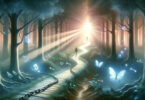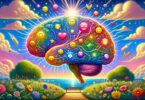By Konstantin Eriksen
Guest Writer for Wake Up World
When you know what to look for, it becomes obvious. In the natural world all around us, intricate and beautiful patterns are everywhere: In the way that plants branch out as they grow, in the way clouds form and dissipate, from vast mountain ranges to tiny grains of sand, similar patterns repeat themselves, over and over again.
And yet this uncanny tendency of the universe to form self-similar patterns on every imaginable scale has been ignored by all official “science” for about 300 years since the Renaissance and the Newtonian scientific revolution. All of what we know as “modern science,” has been based on the Newtonian paradigm of the so-called “clockwork universe,” in which the entire cosmos and everything in it are considered to be machines. Machines that have no consciousness, but merely act out their predetermined roles in the world.
It was this dogmatic world view that led to the development of modern medicine and its emphasis on pharmaceutical drugs, or the Industrial Revolution with its emphasis on turning people into the slaves of industry. All this because living beings are considered to be automatons, programmed by their genes and powerless to create real change in themselves.
The First Glimmer Of Hope
In reality, all this changed with the discoveries of a little-known British scientist named Alan Turing. Turing saw these patterns in all living things and he believed that all biological systems must actually have a mathematical basis. He thought he could describe them with equations.
In 1951 Turing published a scientific paper that should have revolutionized the scientific world. Turing asked the following question: How could the undifferentiated cells in a human embryo become a human body? How do the cells know if they are to become skin cells or brain cells? Turing’s incredible paper applied physics equations to the problem of embryonic cells and proved that morphogenesis (the process of cell differentiation) was a mathematical process.
Although he didn’t come up with the exact equations, Turing left no doubt that life processes could have an underlying mathematical description and an inherent form of intelligent self-organization.
Turing concluded that all the patterns in living beings, both visible and invisible, were the result of invisible mathematical processes, as Pythagoras had more than 2000 years ago. Things as diverse as the shape of broccoli and black spots on a dalmatian all had a similar mathematical explanation behind them.
His fate? Turing was attacked by the scientific establishment, convicted of homosexuality (which was then a crime in Britain) and his discovery was buried.
Enter Benoit Mandelbrot
The man who actually systematized the concepts touched upon by Turing was a frenchman named Benoit Mandelbrot. Mandelbrot annoyed the mathematitians of his day to no end, when he asserted that absolutely nothing in nature could be described by the traditional geometry of university mathematicians and scientists. As he said in the intro to his book on fractals:
Clouds are not spheres, mountains are not cones, coastlines are not circles, and bark is not smooth, nor does lightning travel in a straight line.
Not only did Mandelbrot notice that all patterns in nature are similar. He actually went one step further: He discovered that all of these patterns, regardless if they are patterns from jungles, coastlines, lightning or any other natural process, can be described by a similar type of equation, because the way that natural beings evolve is self-similar.
Ever notice how all maple trees look similar but no two are ever the same? Or how seashells and beaches are all variations on the same theme? That’s what Mandelbrot Fractals are about. I find it truly amazing that by using a very simple equation and changing a few parameters, you can generate a computer image to imitate almost any natural phenomenon.
The number of fractals in nature is truly astonishing. In fact, most special effects in Hollywood movies today involve fractals. Star Wars and The Lord Of The Rings are just two of a very long list of movies that used software-generated fractals to imitate fire and other on-screen effects.
Fractals are everywhere. The has been shown to have a fractal pattern. All plants grow and develop in a fractal-like way. The human body is full of fractals, from the bronchial tubes, to the blood vessels to the way the cells organize themselves.
What Does All This Mean?
To me, the obvious conclusion is that there is an inherent form of intelligence in nature. In a sense, the cosmos has a form of consciousness. On every scale imaginable, from biological cells, to ferns, to mountain ranges, to galaxies, nature finds a way to self- organize amidst the apparent chaos.
I believe that the reason that this intrinsic natural intelligence is hardly ever promoted by the media or “education” system is that it destroys a lot of ideas that the establishment wants people to hold on to. Ideas such as the presumption that we are controlled by our genes, that evolution always happens by accident, or that we are designed to sit in cubicles all day and do menial jobs in order to merely survive or to be good “consumers.”
If people really knew what nature was like, it could shock them out of their complacency. And that is never a good thing for the the ruling elite in any society.
No matter what the official story is that we’re told, it’s becoming more and more obvious with every new scientific discovery that nature actually favours the creation of complex living beings. After all, after the last mass extinction, it only took about 200.000 years for a complete array of new high-level, complex organisms to arise.
And that, they haven’t been able to explain using random, natural selection theory.
About the Author
Konstantin Eriksen is a former stock-trader. After quiting his job, he studied biochemistry and got into natural health and the internal martial arts.

If you've ever found value in our articles, we'd greatly appreciate your support by purchasing Mindful Meditation Techniques for Kids - A Practical Guide for Adults to Empower Kids with the Gift of Inner Peace and Resilience for Life.
In the spirit of mindfulness, we encourage you to choose the paperback version. Delve into its pages away from screen glare and notifications, allowing yourself to fully immerse in the transformative practices within. The physical book enriches the learning process and serves as a tangible commitment to mindfulness, easily shared among family and friends.
Over the past few years, Wake Up World has faced significant online censorship, impacting our financial ability to stay online. Instead of soliciting donations, we're exploring win-win solutions with our readers to remain financially viable. Moving into book publishing, we hope to secure ongoing funds to continue our mission. With over 8,500 articles published in the past 13 years, we are committed to keeping our content free and accessible to everyone, without resorting to a paywall.







